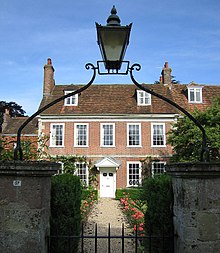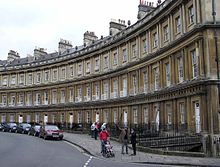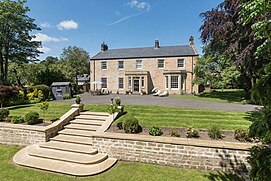
Back عمارة جورجية Arabic Геаргіянская архітэктура Byelorussian Arquitectura georgiana Catalan Georgiánská architektura Czech Georgiansk arkitektur Danish Georgianische Architektur German Georga arkitekturo Esperanto Arquitectura georgiana Spanish معماری جرجی Persian Yrjöjen aikakauden arkkitehtuuri Finnish




Georgian architecture is the name given in most English-speaking countries to the set of architectural styles current between 1714 and 1830. It is named after the first four British monarchs of the House of Hanover, George I, George II, George III, and George IV, who reigned in continuous succession from August 1714 to June 1830.
The Georgian cities of the British Isles were Edinburgh, Bath, pre-independence Dublin, and London, and to a lesser extent York and Bristol.[1] The style was revived in the late 19th century in the United States as Colonial Revival architecture and in the early 20th century in Great Britain as Neo-Georgian architecture; in both it is also called Georgian Revival architecture.
In the United States, the term Georgian is generally used to describe all buildings from the period, regardless of style; in Britain it is generally restricted to buildings that are "architectural in intention",[2] and have stylistic characteristics that are typical of the period, though that covers a wide range.
The Georgian style is highly variable, but marked by symmetry and proportion based on the classical architecture of Greece and Rome, as revived in Renaissance architecture. Ornament is also normally in the classical tradition, but typically restrained, and sometimes almost completely absent on the exterior. The period brought the vocabulary of classical architecture to smaller and more modest buildings than had been the case before, replacing English vernacular architecture (or becoming the new vernacular style) for almost all new middle-class homes and public buildings by the end of the period.
Georgian architecture is characterized by its proportion and balance; simple mathematical ratios were used to determine the height of a window in relation to its width or the shape of a room as a double cube. Regularity, as with ashlar (uniformly cut) stonework, was strongly approved, imbuing symmetry and adherence to classical rules: the lack of symmetry, where Georgian additions were added to earlier structures remaining visible, was deeply felt as a flaw, at least before John Nash began to introduce it in a variety of styles.[3] Regularity of housefronts along a street was a desirable feature of Georgian town planning. Until the start of the Gothic Revival in the early 19th century, Georgian designs usually lay within the Classical orders of architecture and employed a decorative vocabulary derived from ancient Rome or Greece.
- ^ St John Parker, Michael. (2013). Life in Georgian Britain. Gloucestershire: Pitkin Publishing. ISBN 9780752491622. Retrieved 3 May 2021.
- ^ A phrase used by John Summerson, distinguishing among commercial buildings, Summerson, 252
- ^ Musson, 33–34, 52–53